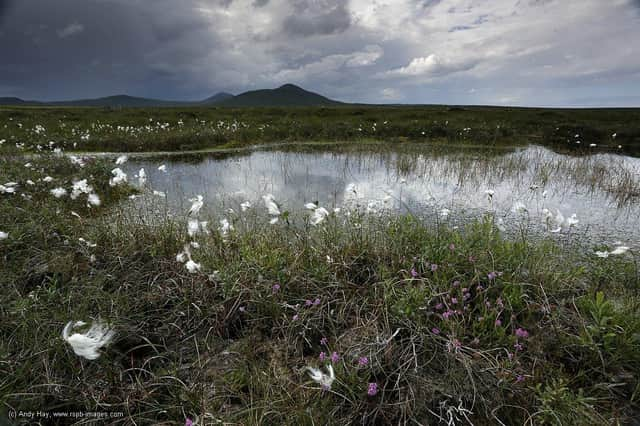Erica Mason: For peat’s sake, we need to protect habitats like the Flow Country


Walking across the expanse of the Flow Country on the boardwalk to the viewing tower, you can hear each footstep on the wood, the squelch of the peat below and the movement of the water. Here, scale is mirrored in reverse – as vast as the open space confronting people looking out across the Flow Country is the sheer magnitude of what is contained in the peat under their feet.
The Flow Country is Europe’s largest expanse of blanket bog. In some places where the peat can reach 10 metres deep, it is as old as 10,000 years. Although peatlands like the Flow Country cover just 3 percent of the world’s land area, they contain 30 percent of all terrestrial carbon. The Flow Country stores more than three times the amount of carbon found in all of Britain’s woodland, and serves as a critical space for wildlife, water regulation and water quality.
Advertisement
Hide AdAdvertisement
Hide AdWhen peatland is damaged or degraded, however, not only is the richness of wildlife lost, but the blanket bogs release carbon amounting to 10 per cent of all global emissions. The same principle applies to other ecosystems and natural habitats as well. When ecosystems are degraded, poorly managed or unprotected, they contribute to both global warming and loss of wildlife. Healthy ecosystems are vitally important for our native wildlife, carbon storage and protecting people from the impacts of climate change. Managing them well turns them into nature-based solutions to the climate emergency.


Nature-based solutions highlight the connection between nature and the climate. Biodiversity plays a key role in the healthy functioning and resilience of ecosystems. Successful nature-based solutions enhance biodiversity, rather than limit it, and are used alongside other essential action – including the phasing out of fossil fuels.
Importantly, they are supported globally through the United Nations Environment Programme, which emphasises the opportunities in 2020 “to bring nature into development, biodiversity and climate solutions in a coherent way and at unprecedented scale”.
Peatland restoration is just one of many mechanisms through which Scotland can implement nature-based solutions. In a conference later in the year, Scottish Natural Heritage (SNH) is bringing together government agencies, charities, businesses, researchers, community groups and others to highlight the great amount of collaboration already happening across organisations and to foster opportunities to work together on nature-based solutions in Scotland.
Across the country, multiple organisations are working to highlight the importance of biodiversity, as well as manage and protect nature. Scottish Environment LINK brings together many of these organisations, offering a forum for 39 member bodies, including the Soil Association, BugLife, Woodland Trust and Scottish Wildlife Trust to work together on effective environmental protections and biodiversity targets that will foster a more environmentally sustainable society.
It is enormously important that the public know about and are involved on this topic as well. Scottish Environment LINK, in partnership with SNH and the Royal Botanic Garden Edinburgh, is giving the public an opportunity to hear more about these efforts as part of a two-day event this summer at the Botanic Garden.
Conservation organisations from around the country, including RSPB Scotland, Nourish Scotland, and PlantLife will be featured at a series of sessions in which they discuss their work on nature-based solutions and efforts to preserve Scottish biodiversity. There will be opportunities for people of all ages to engage with Scottish wildlife and ask questions about nature-based solutions.
At Forsinard Flows, you will find a dwarf birch tree, sustained by the peat and unique to the blanket bog in Scotland. The leaves of the dwarf birch, like those of the larger tree, change colour in autumn, though it rarely grows taller than 30 centimetres. This tiny tree is part of the special ecological community at the reserve, which makes it an incredible place to visit. But it’s also a signal of natural health, of the potential that Scotland’s nature holds for our future.
Advertisement
Hide AdAdvertisement
Hide AdAppreciating ecosystems like these is not enough – we must learn how to protect them, and to work together to support solutions to the nature and climate crisis that exist right here in Scotland. The Make Space for Nature Fringe Event at the Royal Botanic Garden Edinburgh will take place later in the summer.
A full programme from SNH, RBGE and Scottish Environment Link will be available on social media in the coming months – see Twitter: @RSPBScotland for further details.
Erica Mason, policy and campaigns officer, RSPB Scotland